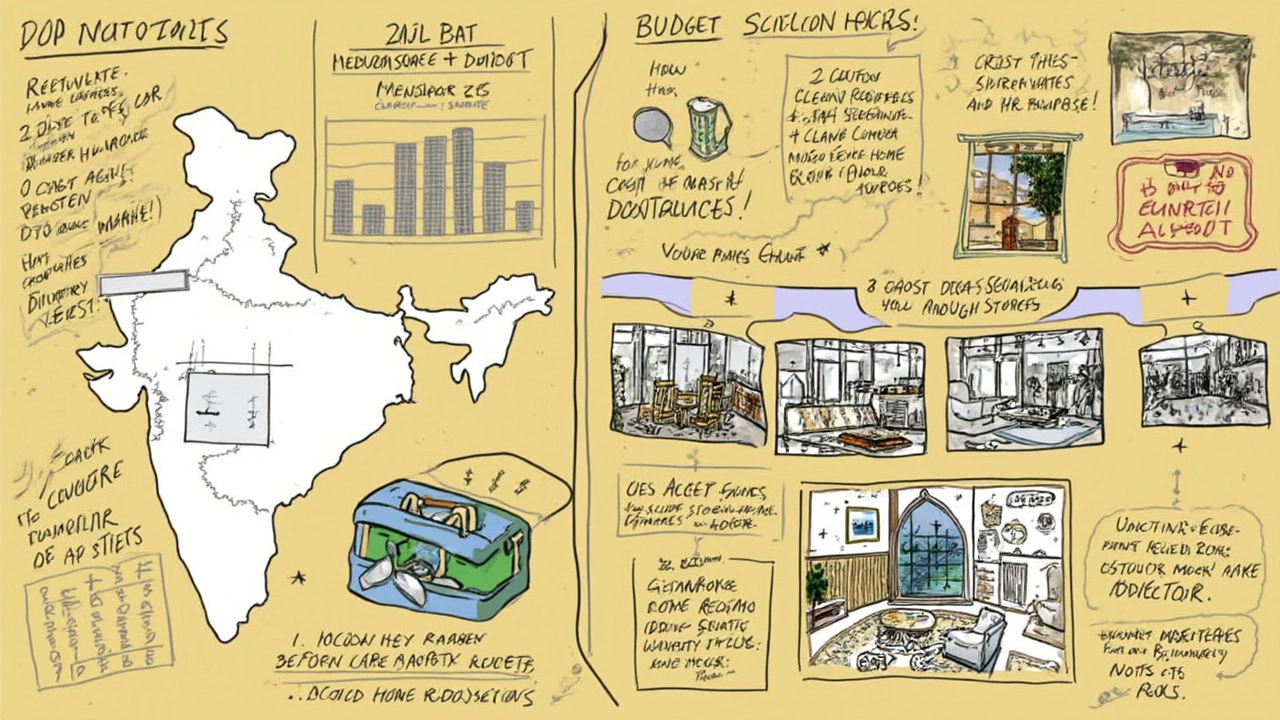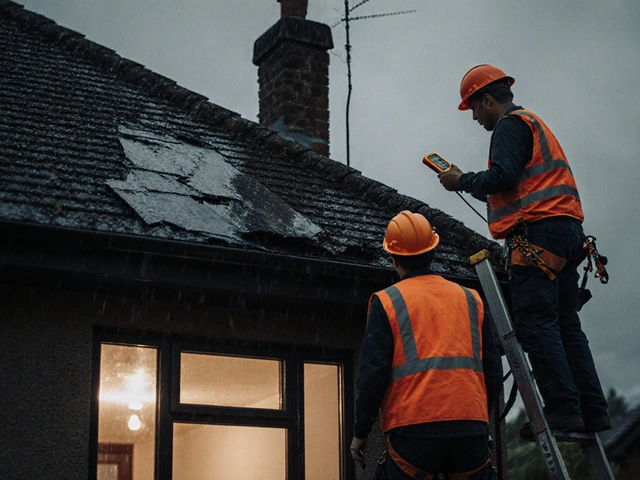Sink $100,000 into a renovation and you might expect a picture-perfect home at the end. Reality check—not all projects turn out like the shows on TV. Actually, $100,000 can disappear a lot faster than you think, especially if your house needs more than just a facelift.
It all comes down to what you want done, how much the place needs fixing, and where you live. In some neighborhoods, $100,000 is enough for a full interior overhaul. In others, it might barely touch the kitchen and bathrooms. Material prices and labor costs climb steadily, and surprise problems love popping up behind old walls.
If you’re thinking about updating a kitchen, replacing floors, or building an extra bathroom—choose carefully. Value adds up fast, but so do bills. That’s not to say it’s impossible to make $100,000 work. But you won’t get everything on your wishlist, and knowing what really matters can help you focus your money for maximum punch.
- Where the Money Goes: Breaking Down Renovation Costs
- What $100,000 Gets You in Different Locations
- Stretching Your Budget: Smart Tricks and Pitfalls
- Must-Have Upgrades vs. Nice-to-Have Luxuries
- Real-Life Renovation Experiences and Takeaways
Where the Money Goes: Breaking Down Renovation Costs
Start talking about a home renovation budget, and you'd be amazed how fast the basics start eating up that $100,000. The biggest bites usually come from labor and materials. It's pretty normal for labor alone to take up 35-45% of your total budget. Think about it—plumbers, electricians, carpenters, and painters all need to get paid. Then you've got the actual stuff: wood, tile, cabinets, lights, and appliances. With prices on the rise since 2021, most contractors are charging 10-20% more for materials than they did just a few years ago.
To give you an idea of typical costs, here's how a budget might get sliced up in a full-house remodel:
| Item | Rough % of Budget |
|---|---|
| Labor | 40% |
| Materials | 35% |
| Permits/Fees | 5% |
| Design/Plans | 5% |
| Contingency (Unexpected costs) | 10% |
| Other (dumpsters, small tools) | 5% |
Kitchens and bathrooms usually chew up the most cash per square foot. A kitchen renovation can run anywhere from $25,000 to $50,000 just on its own, especially if you want new cabinets, flooring, and appliances. Bathroom remodels? Think in the $15,000 to $30,000 range each, and that's being reasonable.
Don’t forget the hidden money pits—outdated wiring, old plumbing, or bad insulation inside the walls. Asbestos or mold? You’re looking at thousands more. That’s why most experts say you need a cushion for surprise expenses, often 10% of your whole renovation budget.
If you’ve got $100,000 and big dreams, you’ll need to plan carefully. Every square foot you renovate adds to the total, so keeping the project focused makes your money go a lot further. It’s a juggling act—move some funds away from custom features or fancy appliances to make sure the basics (like safe electrical and solid plumbing) are covered first.
What $100,000 Gets You in Different Locations
How far does $100,000 really go in a home renovation? The answer looks totally different depending on where you call home. The biggest reason is labor—for example, a contractor in New York is going to charge you a lot more than one in Kansas City. Materials cost more in big cities, too, and sometimes just getting permits drains your wallet faster than you’d think.
Let’s break it down with some real numbers. In places like Charlotte or Houston, you might fully remodel a three-bedroom home: kitchen, a couple bathrooms, new floors, and a fresh coat of paint throughout. In Los Angeles or the Bay Area? That same $100,000 might barely cover a mid-range kitchen and bath, with enough left over for minor cosmetic upgrades in a small condo.
| City | What $100,000 Covers |
|---|---|
| Cleveland, OH | Full interior reno for 1600 sq ft (kitchen, baths, repaint, new flooring) |
| Austin, TX | Nice kitchen, two bathrooms, some new windows |
| Los Angeles, CA | Mid-level kitchen reno plus half-bath, maybe new floors in main living area |
| New York, NY | High-end bathroom and a budget kitchen, very little else |
Material choices make a huge difference, too. Quartz counters and imported tile eat up your budget, while laminate and subway tile let you upgrade more spaces for less cash. Plus, older homes are wildcards; cities with older houses—like Boston—can chew up $100,000 fast if things like wiring or plumbing are out of date.
Here are some ways to figure out how far your remodeling costs will actually go near you:
- Ask local real estate agents what buyers expect in your market.
- Check local Facebook groups or talk with neighbors who recently renovated.
- Get itemized quotes from at least three contractors.
- Always leave room for the “surprise” fund, because old pipes and hidden leaks are almost a guarantee.
Bottom line: $100,000 stretches a lot further in some towns than others. If you live in a high-cost city, focus on fixing up just one or two spaces really well instead of trying to redo everything halfway.

Stretching Your Budget: Smart Tricks and Pitfalls
If you want a solid home renovation without blowing your entire $100,000, you’ve got to be sharp with the planning and ruthless with the budget. Contractors will tell you—every project has hidden costs. Get ahead of those surprises instead of fighting them mid-job.
The best way to save money? Do your homework up front. Get at least three quotes for every major job, and compare what’s included. Don’t just jump at the lowest price—hidden fees and vague language are red flags. And ask for an itemized breakdown. If a contractor can’t give you those details, it’s usually a sign to look elsewhere.
Materials can eat up more of your budget than you’d expect. Want hardwood instead of vinyl? That upgrade can double or triple the cost for a single room. If your heart isn’t set on marble countertops or high-end fixtures, shop for alternatives. There’s a massive gap in price between builder-grade and luxury items, but not always a huge difference in looks or performance for average homes.
- Buy major items during big holiday sales—appliances, flooring, and even cabinetry can drop by 20% or more.
- Don’t toss out everything: refinishing cabinets or patching up wood floors saves thousands versus total replacement.
- Handle light demo or painting yourself if you’re handy—just don’t touch anything structural, electrical, or plumbing if you’re not licensed.
- Keep project changes to a minimum after work starts. Change orders slow everything down and the extra charges add up fast.
It’s easy to get carried away when you start picking out finishes, so decide in advance where you’ll splurge and where you’ll save. Maybe you really want a show-stopping kitchen but don’t care as much about the laundry room—push your money toward what matters most.
| Renovation Element | Low-Cost (Per Sq. Ft.) | Mid-Range (Per Sq. Ft.) | High-End (Per Sq. Ft.) |
|---|---|---|---|
| Flooring | $2 | $5 | $15+ |
| Cabinets | $60/linear ft | $150/linear ft | $500+/linear ft |
| Countertops | $30 | $60 | $100+ |
On the flip side, don’t get so focused on saving that you cut corners. Hiring a cheap handyman for plumbing or electrical can end up costing double if stuff fails inspection or causes damage. Don’t ignore permits, either. Unpermitted work can mess with home resale, refinancing, or insurance claims.
One more tip I wish I’d known earlier: build a cushion of at least 15% in your budget for stuff you can’t see or predict. Trust me—nobody likes finding out mid-renovation that you’ve got old wiring or hidden water damage. Having a backup fund keeps stress in check and the project moving forward.
Must-Have Upgrades vs. Nice-to-Have Luxuries
If you’re working with a home renovation budget, $100,000 isn't a blank check—it’s often about picking what actually matters most. To really stretch your money, start by putting must-haves first. These are the basics, the updates that keep your place safe, dry, and liveable. After that, see what’s left for those wish-list luxuries.
Must-haves include things you really shouldn't ignore. Old electrical panels, a leaky roof, busted plumbing, or sketchy foundations—all of that needs fixing before you start ripping out carpet just because shag is out of style. Knocking out issues like these can eat up a remodeling costs budget fast, but skipping them means possible disasters down the road.
- Electrical and plumbing: Outdated wiring and pipes aren’t just annoying—they’re fire and flood risks.
- Roofing and water damage: Leaks destroy houses. Patch the roof and fix any mold or rot first.
- Windows and insulation: Old windows and thin walls jack up your energy bills. Swapping them saves cash long-term.
- Heating and cooling systems: If your furnace croaked in 1984, replacement is a better move than that marble countertop.
Once you've locked down the essentials, you can start dreaming. Here’s the harsh truth: high-end extras, like radiant floor heating, smart toilets, or a six-burner range, eat money faster than you’d expect. Most buyers won’t pay you back for gold-plated faucets, but they will care about a solid HVAC system or a modern kitchen that works.
- Heated towel racks
- Professional-grade appliances
- Expensive quartz or marble counters
- Custom lighting systems
- Designer tile mosaics
For context, here’s a quick comparison of typical project costs so you know where your money’s going:
| Upgrade | Average Cost (US, 2025) |
|---|---|
| Roof replacement | $8,500 - $16,000 |
| Full kitchen remodel | $25,000 - $50,000 |
| Bathroom remodel | $12,000 - $25,000 |
| HVAC replacement | $7,000 - $15,000 |
| Custom built-ins | $5,000 - $15,000+ |
Want my honest advice? Spend on problems that hit your house's basics and keep you comfortable. Nice-to-haves are just that—nice, but not essential. Prioritizing these will actually help your budget go further and protect your investment.

Real-Life Renovation Experiences and Takeaways
Here’s where the rubber meets the road. You can plan your home renovation down to the last nail, but once hammers start flying, reality jumps in. Let me share a few personal stories and hard lessons from people who put their $100,000 to the test.
First up—my friend Casey tried to open up her 1980s split-level, focusing on new floors, an open kitchen, and two bathrooms. She budgeted $100,000, but surprise: the contractor found water damage and ancient wiring. That meant $19,000 vanished replacing pipes and wires nobody will ever see. By the time the job wrapped up, the kitchen ended up a little simpler than planned, but at least the place is safe.
On the other hand, a couple in Houston managed a remodeling marathon. They tackled the kitchen, two baths, and fresh paint throughout. Their trick? They did a lot themselves and chose classic, durable finishes instead of high-end brands. They made their budget stretch by shopping around, reusing cabinet boxes, and even picking up tile during a big-box clearance event. The result wasn’t luxury, but it looked great and added solid value.
Loads of people hit the same snag: labor eats up a giant chunk of the money, fast. According to HomeAdvisor, more than 40% of a renovation budget can go just to skilled work. It’s common for people to hope for new floors, upgraded lighting, and an expanded bathroom, only to settle for fewer upgrades. The best outcomes come from staying realistic, keeping a close eye on costs, and always having a 10-15% “surprise” fund.
| Project | Location | Main Focus | Final Cost | Biggest Lesson |
|---|---|---|---|---|
| Split-Level Basic Reno | Oregon | Kitchen/Baths | $108,000 | Factor in hidden repairs |
| DIY Value Remodel | Texas | Whole House | $98,000 | DIY and sales save big |
If you’re dreaming up your own home improvement, here’s what I learned with my wife, Elena, when we redid our old bungalow. We prioritized must-haves: better insulation and structural repairs. The cool extras, like built-in bookshelves and that fancy shower, got put on hold. It stings in the moment, but keeping the budget safe was worth it.
- Always get at least three quotes for every big job.
- Look for sales, reuse materials, and don’t ignore stores like Habitat for Humanity ReStore for bargains.
- Don’t skip permits or inspections for shortcuts—they’ll bite back during resale.
Every house is different, and no two renovation stories are the same. But most people agree: $100,000 buys a lot more joy when you focus on what truly matters, expect curveballs, and spend with your head, not just your heart.






